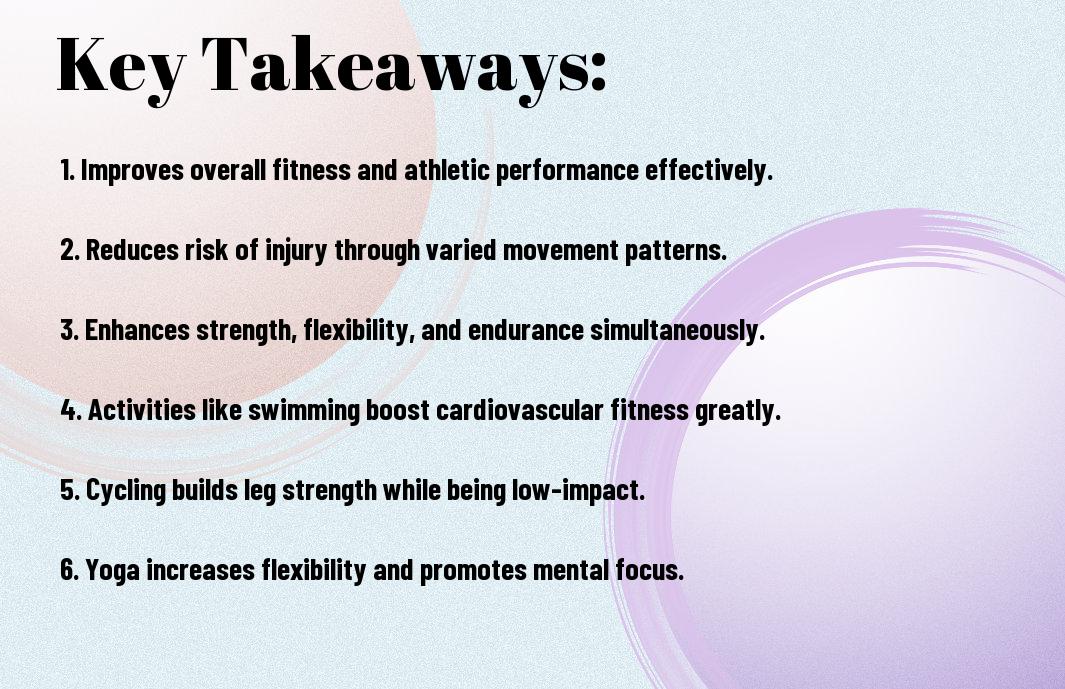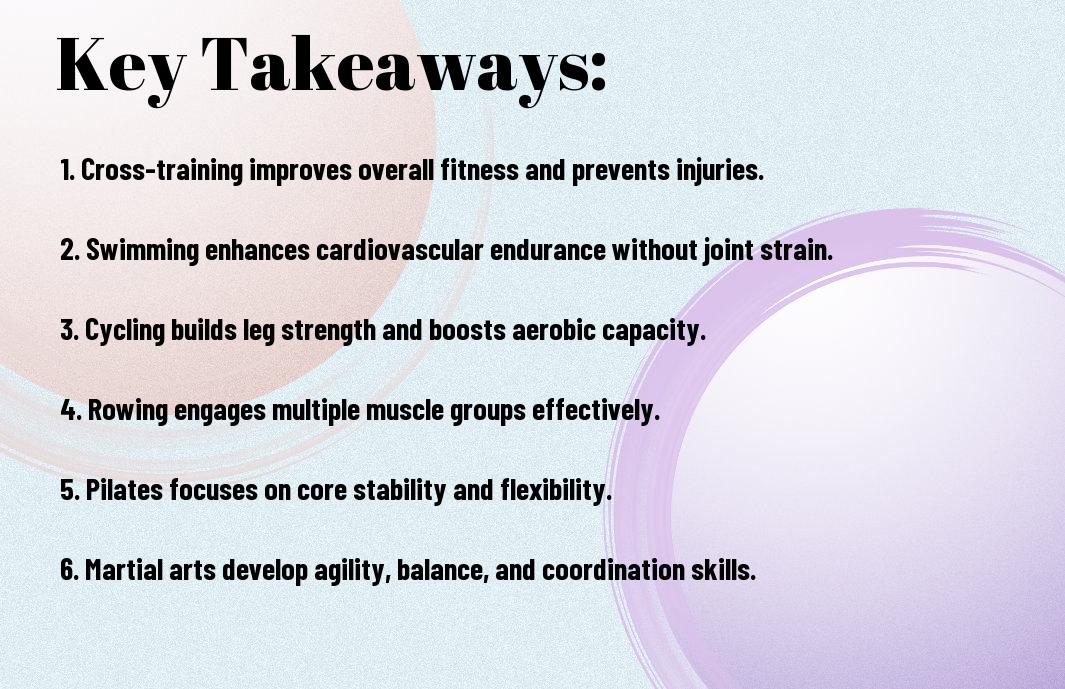It’s crucial to diversify your training routine to enhance performance and prevent injury. Engaging in cross-training activities can significantly benefit your overall athleticism by improving strength, flexibility, and endurance. In this blog post, we will explore some of the best cross-training options available to you, allowing you to enhance your skills, break through plateaus, and keep your workouts fresh and exciting. Whether you’re a seasoned athlete or just starting, incorporating these activities can help propel you toward your goals.

Key Takeaways:
- Variety: Incorporating different activities prevents boredom and engages various muscle groups, enhancing overall athletic ability.
- Endurance Building: Activities like cycling and swimming improve cardiovascular fitness, supporting long-duration performance.
- Strength Development: Resistance training and weight lifting increase muscle strength and power, benefiting all sports.
- Flexibility: Yoga and Pilates promote flexibility and balance, which are imperative in preventing injuries and improving performance.
- Mental Recovery: Engaging in low-intensity activities can provide psychological relief, aiding recovery and maintaining motivation.
Benefits of Cross-Training for Athletes
While focusing on a single sport can help you sharpen specific skills, incorporating cross-training activities provides a myriad of benefits that enhance your overall athleticism. By engaging in various exercises, you boost your physical conditioning, improve your flexibility, and develop a more well-rounded skill set. This variety not only keeps your training fresh and exciting but also prepares you to face challenges in competition with greater resilience.
Enhanced Performance
Besides improving your endurance and strength, cross-training can lead to enhanced performance in your primary sport. By incorporating different activities, you engage underused muscle groups, which allows for a more balanced body. This well-rounded approach helps increase power output and provides you with a unique edge during competition, making you a more versatile athlete.
Injury Prevention
Benefits of cross-training for injury prevention cannot be overstated. Balancing your workout routines with various forms of exercise allows you to strengthen different muscle groups, thereby reducing the risk of overuse injuries common in specialized training. By promoting muscular balance and flexibility, you create a solid foundation that supports your primary sport and minimizes the likelihood of setbacks.
The inclusion of cross-training in your regimen acts as a safeguard against injuries by diversifying the physical demands placed on your body. Engaging in activities such as swimming, cycling, or yoga helps alleviate strain on repetitive motion injuries while strengthening stabilizing muscles. As a result, not only do you improve your athletic performance, but you also cultivate a more durable physique capable of enduring the rigors of intense training and competition.

Popular Cross-Training Activities
There’s a wide range of cross-training activities available for athletes looking to enhance their performance. Incorporating different exercises into your routine not only increases your strength and endurance but also helps to minimize the risk of injury and prevents workout monotony. Knowing which activities can benefit your training concentration, you can select the ones that resonate best with your fitness goals.
Swimming
Any athlete can benefit from swimming, as it provides a full-body workout while being gentle on your joints. This low-impact exercise enhances cardiovascular fitness, builds muscle strength, and improves flexibility. Additionally, swimming engages multiple muscle groups, giving your body a balanced form of cross-training.
Cycling
Any athlete seeking to build endurance will find cycling to be a fantastic option. This versatile workout can be adjusted to suit various fitness levels, making it accessible whether you’re a beginner or seasoned pro.
In fact, cycling not only boosts your cardiovascular health but also strengthens your lower body, particularly your quadriceps, hamstrings, and calves. Alternatively, you can engage in road cycling for endurance or stationary biking at a gym for controlled environments. Both options help increase your stamina and allow for targeted recovery from high-impact sports.
Rowing
About rowing, athletes can experience an effective low-impact workout that targets both upper and lower body muscles. This total-body exercise improves cardiovascular fitness while simultaneously building strength, making it ideal for cross-training.
In addition, rowing mimics many movements found in sports, allowing you to develop coordination and power. By incorporating a rowing machine into your training regimen, you can boost your aerobic capacity, enhance endurance, and improve muscle tone—beneficial aspects for any athlete looking to elevate their performance.
Pilates
On the topic of Pilates, this practice focuses on core strength and stabilization, both imperative for athletic performance. It enhances flexibility and helps with postural alignment, thus reducing the risk of injury during other activities.
But incorporating Pilates into your cross-training routine can also improve your overall body awareness, which translates into better control and efficiency in your primary sport. Many athletes find that the increased core stability gained through Pilates assists in their other training efforts, leading to improved performance.
Sport-Specific Cross-Training
All athletes can benefit from sport-specific cross-training, which refers to engaging in activities that enhance skills and fitness relevant to your primary sport. By incorporating exercises that mimic the movements and energy systems of your sport, you can boost performance, reduce injury risk, and maintain motivation. Tailoring your cross-training strategy to your sport allows you to improve specific strengths and weaknesses, ultimately enhancing your overall game.
Cross-Training for Runners
SportSpecific cross-training for runners can involve activities such as cycling, swimming, or using an elliptical machine. These low-impact exercises help you build endurance while reducing the wear and tear on your joints. Incorporating strength training targeting your core and leg muscles will also improve your running efficiency. Moreover, yoga and Pilates can enhance flexibility and balance, important components for injury prevention and performance improvement.
Cross-Training for Team Sports
At your level, cross-training for team sports can significantly enhance your performance on the field or court. Incorporating drills and exercises that emphasize agility, coordination, and teamwork will help develop the skills directly related to your sport. Activities such as high-intensity interval training (HIIT) or specific plyometric exercises can improve your explosiveness and stamina, which are vital in competitive scenarios.
Hence, including sport-specific drills in your cross-training routine not only aids in physical fitness but also reinforces tactical awareness associated with your team sport. Skills like passing, shooting, or strategic positioning can be practiced through tailored drills during cross-training sessions. This way, you maintain sharpness in key areas while diversifying your workouts, keeping your training dynamic and engaging. Being committed to cross-training will undoubtedly lead to improvements in your overall performance when competing with your team.
How to Incorporate Cross-Training into Your Routine
After understanding the importance of cross-training, you can seamlessly incorporate it into your routine. Start by assessing your current training schedule and identify gaps where cross-training can fit in. Aim for a balanced mix of activities that complement your primary sport, allowing you to stay motivated and prevent burnout. Consistency is key, so try to make cross-training a regular part of your week, and adjust as necessary to match your goals and commitments.
Scheduling and Frequency
Below are some suggestions for how to effectively schedule your cross-training workouts. Start with two to three sessions per week, ensuring that you allow for adequate recovery between high-intensity workouts. You can either replace a standard training day with a cross-training session or incorporate shorter activities into your existing regimen. Over time, you can gradually increase the frequency as your body adapts and your overall fitness improves.
Selecting the Right Activities
Incorporate cross-training activities that align with your fitness goals and target different muscle groups. Consider exercises that enhance strength, endurance, flexibility, or mobility, depending on your primary sport. Activities like swimming, cycling, or yoga can enhance overall fitness while reducing the risk of injury. Experiment with different options to find what you enjoy most and what complements your main training regimen.
And as you explore various cross-training options, think about how each activity contributes to your overall performance. For instance, if you’re a runner, cycling may boost your cardiovascular endurance without over-stressing your joints. Similarly, practices like Pilates or yoga can aid in flexibility and core strength, imperative for many athletes. Choose activities that excite you and challenge your body in new ways, keeping your training fresh and engaging.
Common Mistakes to Avoid
Unlike many athletes, you should be aware that effective cross-training requires balance and strategy. Avoid jumping from one activity to another without proper planning, as this can lead to burnout or hinder your performance. Planning a structured schedule will help you maximize your benefits from cross-training while preventing injuries.
Overtraining
For athletes, maintaining a consistent training routine is important, but overtraining can lead to decreased performance and increased risk of injury. Ensure you incorporate rest days and allow your body time to recover, as pushing your limits continuously can be counterproductive.
Neglecting Specific Skills
Between focusing on general fitness and cross-training, you might overlook the specific skills required for your primary sport. Balancing cross-training with sessions dedicated to honing those skills is vital for optimal performance.
Overtraining can divert your attention from developing the specific skills pertinent to your sport. While cross-training enhances overall fitness, it’s important to dedicate time to drills, strategies, and techniques that directly impact your performance. Creating a training regimen that evenly distributes time between cross-training and skill development will help you maintain proficiency in your sport while improving your overall athleticism.
Summing up
Following this guide, you can enhance your athletic performance by incorporating effective cross-training activities into your routine. Engaging in diverse exercises not only improves your overall fitness but also helps to prevent injuries and alleviate monotony in training. Choose activities that complement your primary sport, whether it’s swimming, cycling, or strength training, and consider your personal preferences to maintain motivation. By integrating these methods, you’ll develop strength, agility, and endurance, equipping you for greater success in your athletic endeavors.
Q: What are some effective cross-training activities for athletes looking to improve strength?
A: Athletes can benefit from strength training exercises such as weightlifting, resistance band workouts, or bodyweight exercises like push-ups and lunges. These activities enhance muscle strength and endurance, which can directly translate to improved performance in their primary sport. Additionally, incorporating exercises that target different muscle groups ensures a well-rounded strength development.
Q: How can cross-training help prevent injuries in athletes?
A: Engaging in cross-training allows athletes to work different muscle groups while giving primary muscles a chance to recover, reducing the risk of overuse injuries. Activities such as swimming or cycling are low-impact options that maintain cardiovascular fitness without placing excessive stress on joints. This variety in training can enhance overall athletic resilience and reduce the chance of repetitive strain injuries.
Q: What is the optimal frequency for incorporating cross-training into an athlete’s routine?
A: The optimal frequency of cross-training varies depending on the individual athlete’s training schedule, the intensity of their primary sport, and personal fitness goals. However, a general guideline is to include cross-training activities 1-3 times per week. It is important for athletes to listen to their bodies and adjust the frequency and intensity to ensure they are supporting their primary training while avoiding fatigue or burnout.



